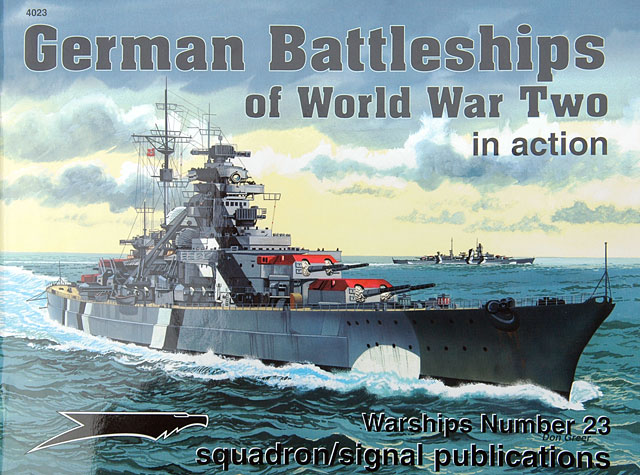|
German
Battleships of World War Two in action

Squadron/Signal
Publications
S u m m a r y
|
|
Catalogue Number: |
Warships Number 23 - German Battleships of
World War Two in action |
|
ISBN: |
0-89747-482-1 |
|
Media: |
Soft
cover, “in action” format, card cover with
50 pages of text, black and white photos,
line drawings by Darren Glenn and excellent
artwork by Don Greer and David Gebhardt. |
|
Price: |
USD$8.96 from Squadron.com |
|
Review Type: |
First
Read |
|
Advantages: |
Covers
the three major battleship classes, lots of
interesting B&W photos and the usual
excellent artwork with German colour names
picked out. |
|
Disadvantages: |
No
deck colours or below-waterline colours
shown or mentioned. |
|
Recommendation: |
Highly
Recommended to ship modellers. |
Reviewed
by Glen Porter

German Battleships of World War Two in action is available
online from Squadron.com
You wouldn’t expect a book on German Battleships of World War Two to
be very thick. After all, there were only seven of them. However it
allows Squadron to concentrate more fully on each of them.
Starting with the first class to be built, the Duetschlands,
Pazerschiffs [Armoured Ships] or Pocket Battleships, as we knew
them, consisted of three ships, Deutschland [later Lutzow], Admiral
Scheer and Admiral Graf Spee. These were not a particularly successful
class as, although they had six eleven inch guns in two turrets, they
only had the armour of a light cruiser. Their closest Allied class of
ship was the battle cruiser but they had speed to make up for their lack
of armour. Indeed, if Admiral Graf Spee had had the speed, there may
have been a very different outcome from the Battle of the River Plate.
However she didn’t have that essential element and this allowed Exeter,
Ajax and Achilles to get far too close to her and suffered irreparable
damage. The class was generally successful as commerce raiders, although
over expensive for that duty, providing they didn’t confront allied
warships.
The next class was far more conventional in that the Germans decided to
ignore the treaties and build whatever ships they wanted. Scharnhorst
and Gneisenau were reasonably good ships although they still had only
eleven-inch guns, which would make it hard for them to confront Allied
Battleships. They were built in such a way that at a later date they
could be fitted with the same guns and turrets as the third and final
class.
Bismark and Tirpitz were the biggest and the best of the German ships.
Although the potential was there they were never really put to the test
and although they were based on a WW I design, they still had the right
mix of armour, armament and speed. Because of the outdated design, the
crew numbers were much higher as evidenced by the loss of life from the
Bismark’s sinking as opposed to the Hood, a comparatively sized ship.
This book covers the three classes very well with design parameters and
service history, heaps of B&W photos and the usual excellent artwork by
Don Greer and David Gebhardt, which brings me to my only criticism.
Nowhere, in the text, captions or artwork is there any mention made of
the deck colours or lower hull colours. The larger scale models of these
ships are all full hull and therefore the under-water colours will be
required. Similarly, for all scales, the deck colour conformation would
be helpful.
Apart from my one little nit pick, this is a very useful reference book
for any ship modeller.
Highly Recommended.
Thanks to
Squadron for
the review sample.
Review Copyright © 2005 by Glen
Porter
This Page Created on 11 January, 2005
Last updated 11 January, 2005
Back to HyperScale
Main Page
Back to Reviews
Page
|
Home | What's
New | Features
| Gallery |
Reviews | Reference
| Forum
| Search